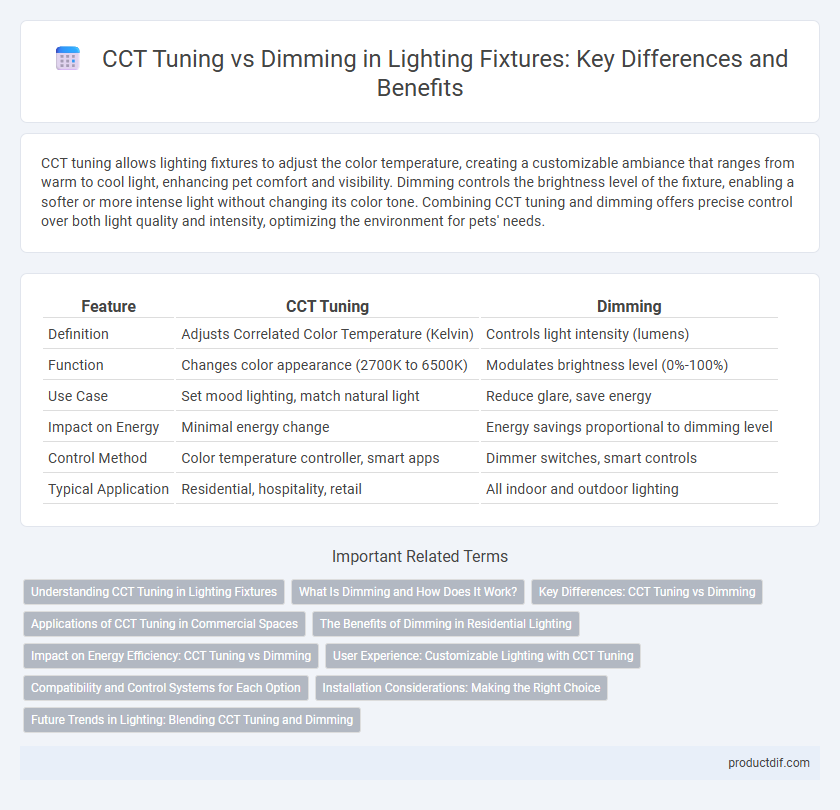CCT tuning allows lighting fixtures to adjust the color temperature, creating a customizable ambiance that ranges from warm to cool light, enhancing pet comfort and visibility. Dimming controls the brightness level of the fixture, enabling a softer or more intense light without changing its color tone. Combining CCT tuning and dimming offers precise control over both light quality and intensity, optimizing the environment for pets' needs.
Table of Comparison
| Feature | CCT Tuning | Dimming |
|---|---|---|
| Definition | Adjusts Correlated Color Temperature (Kelvin) | Controls light intensity (lumens) |
| Function | Changes color appearance (2700K to 6500K) | Modulates brightness level (0%-100%) |
| Use Case | Set mood lighting, match natural light | Reduce glare, save energy |
| Impact on Energy | Minimal energy change | Energy savings proportional to dimming level |
| Control Method | Color temperature controller, smart apps | Dimmer switches, smart controls |
| Typical Application | Residential, hospitality, retail | All indoor and outdoor lighting |
Understanding CCT Tuning in Lighting Fixtures
CCT tuning in lighting fixtures enables precise control over the correlated color temperature, allowing users to adjust lighting from warm (2700K) to cool (6500K) tones based on preference or task requirements. Unlike dimming, which only alters light intensity, CCT tuning modifies the color quality, enhancing ambiance and functionality in residential, commercial, and hospitality settings. Advanced LED drivers and controls facilitate smooth CCT transitions, optimizing energy efficiency and personalized comfort.
What Is Dimming and How Does It Work?
Dimming adjusts the brightness of a lighting fixture by reducing the electrical power supplied to the bulb, allowing for customizable light intensity and energy savings. This process typically involves altering the voltage or using pulse-width modulation (PWM) to control LED output without changing the color temperature. Unlike CCT tuning, which modifies the correlated color temperature (measured in Kelvins) to shift light from warm to cool tones, dimming solely impacts luminosity while maintaining the fixture's original color quality.
Key Differences: CCT Tuning vs Dimming
CCT tuning adjusts the correlated color temperature of a lighting fixture, allowing users to switch between warm, neutral, and cool light tones to create specific ambiance or match changing natural light conditions. Dimming controls the fixture's brightness level by modulating the light output intensity without altering the color temperature, providing energy savings and mood setting. Key differences include CCT tuning's focus on color temperature variation versus dimming's emphasis on light intensity adjustment.
Applications of CCT Tuning in Commercial Spaces
CCT tuning enhances commercial lighting by allowing precise control over color temperature, adapting to various activities such as retail displays, office work, and hospitality environments. This flexibility improves visual comfort, supports circadian rhythms, and elevates ambiance, making spaces more inviting and efficient. Unlike dimming, which only adjusts light intensity, CCT tuning offers dynamic white light customization tailored to specific commercial applications.
The Benefits of Dimming in Residential Lighting
Dimming in residential lighting enhances energy efficiency by reducing power consumption and extending bulb lifespan, resulting in lower utility bills and maintenance costs. It allows for customizable ambiance, improving comfort and mood by adjusting light intensity to suit various activities or times of day. Unlike CCT tuning, which changes color temperature, dimming provides precise control over brightness, making it ideal for creating cozy, relaxed environments in living spaces.
Impact on Energy Efficiency: CCT Tuning vs Dimming
CCT tuning adjusts the correlated color temperature of lighting fixtures, optimizing light quality and human comfort while maintaining a consistent lumen output, which can indirectly influence energy efficiency by promoting appropriate usage patterns. Dimming reduces the light output directly, resulting in immediate energy savings proportional to the reduction in wattage consumed. Energy efficiency improvements are typically more substantial with dimming, though CCT tuning enhances overall lighting performance and occupant satisfaction without compromising power consumption.
User Experience: Customizable Lighting with CCT Tuning
CCT tuning offers users the ability to adjust the color temperature of lighting fixtures, enhancing ambiance and comfort according to personal preferences or task requirements. Unlike traditional dimming, which only controls brightness, CCT tuning provides a customizable lighting experience by shifting from warm to cool light, improving mood and productivity. This flexibility supports dynamic environments, creating tailored atmospheres for work, relaxation, or social settings.
Compatibility and Control Systems for Each Option
CCT tuning fixtures offer enhanced compatibility with advanced control systems by allowing precise adjustment of correlated color temperature, improving ambiance customization in smart lighting setups. Dimming controls focus primarily on luminance reduction and generally integrate with standard dimmer switches or digital control protocols like DALI or 0-10V, prioritizing light intensity control. Selecting between CCT tuning and dimming depends on the desired user interaction, with CCT tuning requiring sophisticated interfaces for color temperature adjustment, while dimming remains compatible with broader, simpler controls.
Installation Considerations: Making the Right Choice
Choosing between CCT tuning and dimming lighting fixtures requires careful evaluation of installation constraints and user needs; CCT tuning allows adjustment of color temperature from warm to cool light, enhancing ambiance but often demands compatible drivers and control systems. Dimming fixtures focus solely on light intensity reduction, generally offering straightforward installation with minimal wiring changes, making them suitable for retrofit projects. Proper assessment of existing electrical infrastructure and desired lighting control capabilities ensures optimal performance and user satisfaction.
Future Trends in Lighting: Blending CCT Tuning and Dimming
Future trends in lighting fixtures emphasize the integration of CCT tuning and dimming technologies to create highly customizable illumination environments. This blend allows users to adjust both color temperature and brightness levels dynamically, enhancing ambiance and energy efficiency in residential and commercial spaces. Advanced control systems leveraging IoT and AI enable seamless user experiences and adaptive lighting performance tailored to circadian rhythms and activity-specific needs.
CCT Tuning vs Dimming Infographic

 productdif.com
productdif.com